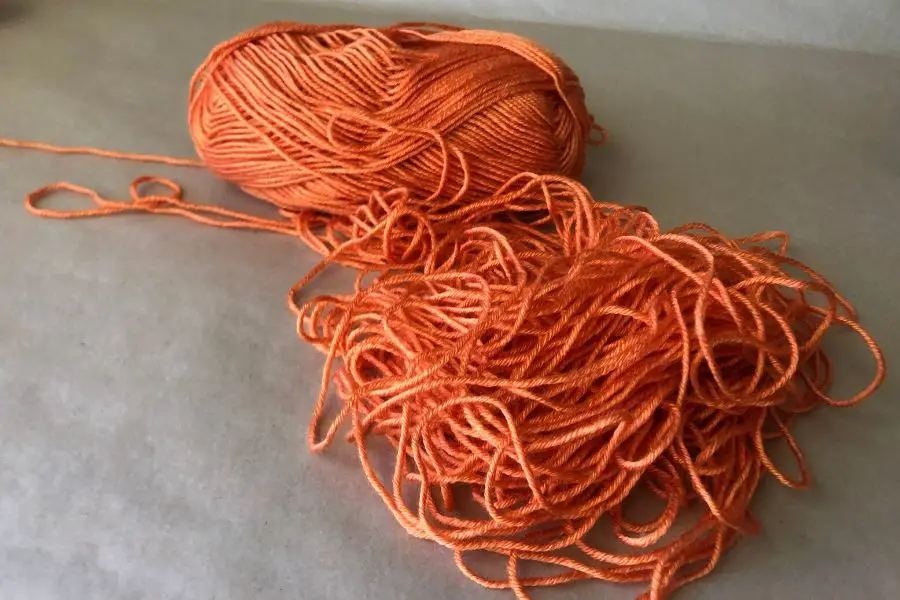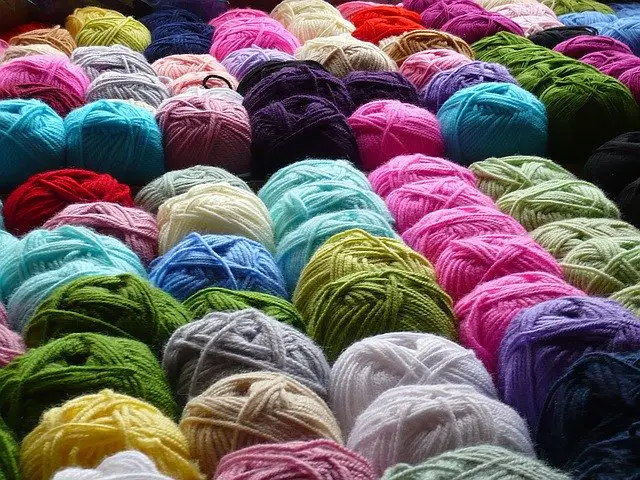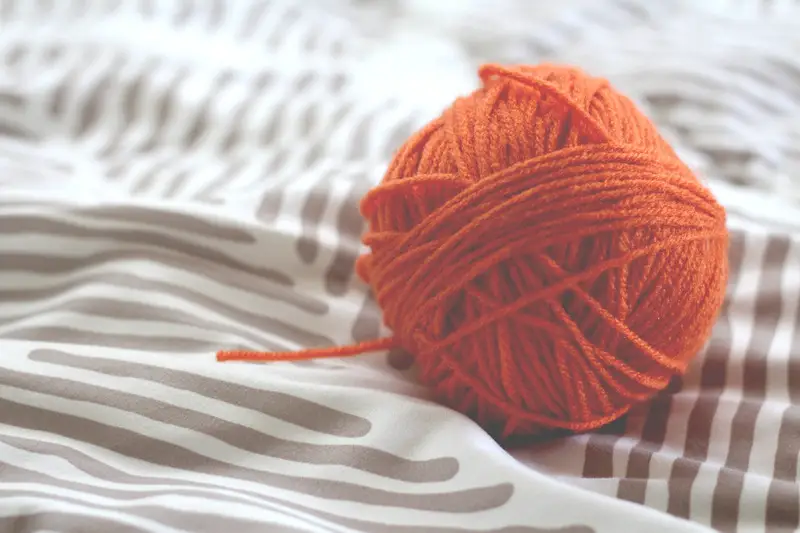Many store bought skeins of yarn leave me frustrated because of the tangled mess of yarn in the middle, even though there is a thread to pull from the center. I searched for a solution and found that yarn winders can solve this problem and do so much more!
What is a yarn winder and how can it help? A yarn winder is a device that wraps yarn into a center pull ball, or “cake” of yarn. The benefits include:
- Time saving.
- Defects in the yarn can be detected.
- Yarn will maintain its elasticity.
- The flat bottom means easy storage.
- Access to both ends of the yarn.
Anyone who is or wants to be a serious knitter or crocheter should consider a yarn winder. In a matter of minutes, a hank can be turned into a perfectly usable yarn ball. I never knew I needed one until I saw it in action. And I would like to explain why such a simple mechanism is so valuable to yarn crafts.
The 5 Reasons to Use a Ball Winder
A ball winder is a magical invention that makes life much easier for knitters and crocheters alike. I compiled a list of the most important reasons a ball winder should be a necessity for serious crafters.
1. It is the best time saving hack for serious knitters and crocheters.

Many skeins that come from chain craft stores claim that they can be pulled from the center, which is supposed to be easier for use. But so often in my experience, the yarn tail is nowhere to be found. Or if it is found, after pulling on it, the yarn inside tangles and I spend the next half hour undoing the string. A ball winder minimizes this issue and saves time in three major ways.
The first major time saver is preventing yarn from tangling. This goes for skeins and hanks. More high end yarn will come in hanks, which is yarn rolled into a big circle then twisted into itself. To use the hank, the yarn must be untwisted back into the big ring. It is necessary to roll a hank into a ball to prevent tangling because the long strands of yarn would otherwise rub together and create a big mess.
If you like to use store bought skeins that come pre-wound, a ball winder does not matter as much. However, it can create an easier and more efficient ball of yarn. Oftentimes when the yarn is pulled from the middle of the skein, the whole center falls out, which people refer to as “yarn barf”. This happens because the pulling motion tightens the yarn around the tail since it was wound inefficiently.
A ball winder can start winding yarn from the outside of a skein. Since pulling from the middle can create a problem, working from the outside in minimizes the tangles. Less tangles means more time to work on your project.
The second way a ball winder can save time is by creating a center pull cake of yarn. The cake is easier to manage because you don’t have to chase after the skein or ball when you pull the yarn. The flat bottom of the ball of yarn wrapped by a ball winder helps the yarn remain in place while it is in use. Your hands can spend more time working on your project.
Finally, a ball winder is faster than hand winding. Manual or electric winders will help you not have to worry about waiting to start on your project after your hands stop cramping.
2. Defects in the yarn can be detected.
When you buy skeins from the store, you cannot see if there are any flaws since the yarn has already been wound into a ball. Sometimes the yarn was cut and tied into a knot to keep the yarn together. A ball winder gives you the opportunity to inspect the yarn for any weak points before getting started on your work. If there are any defects, then you can plan to alter the yarn before getting surprised halfway through your project.
3. Over time the yarn will maintain its elasticity.
Storing yarn properly is important for knitters and crocheters. Winding a ball that has too much tension can put strain on the fibers and cause them to stretch out. Even if you carefully wind the ball yourself, storing it over time in that condition can damage the fibers. This can lead to problems such as an untrue gauge measurement.
A ball winder wraps the yarn in a way that is tight enough to keep the ball together, but loose enough to let the fibers maintain their true form. Just don’t add too much tension, or you could end up with stretched out fibers.
4. Organized storage.

A ball winder wraps the yarn into a cylinder. The flat tops and bottoms allow the yarn cakes to be stacked on top of each other. Ultimately, they can stay more organized than hanks or skeins of yarn because they won’t roll around.
Many projects will leave you with leftover yarn. And by the end of the skein, most times the yarn ball has begun to unravel. A ball winder can tidy up the leftovers for storage.
5. Access to both ends of the yarn.

You can pull from the center or from the side. Both ends of the yarn can come in handy for double stranded knitting. If you have easy access to both ends, you could use them at the same time.
Also, if you need to join two balls of yarn together, the job is easier done when both ends are available.
How Does a Ball Winder Work?
A ball winder resembles a spindle. There is a cone in the middle and a metal arm that sticks straight up. The arm has a loop at the top for holding the tension as the yarn passes through. The manual ball winder can be clamped to any sturdy surface, such as a tabletop, and there is a crank at the end.
For the ball winder to work, there are a few steps to follow.
- Clamp the ball winder to a solid surface.
- Thread the yarn through the loop at the top of the stationary arm.
- Secure the yarn end on the top slit of the cone.
- Crank the handle to begin winding.
- Tuck in the end piece to the outside when done.
- Take yarn off cone.
When you begin cranking the winder, the cone will start spinning but rock back and forth. This movement will wrap the yarn around the cone into a criss-cross cake of yarn. Many crafters that own ball winders will also suggest you hold the yarn to give a little extra tension. The cakes will come out slightly tighter.
There are other variations of ball winders, but they all operate in a similar manner.
Ball Winder Cost
The popular belief is that ball winders cost a fortune. While that is true in some cases, not everyone needs a heavy duty, electric ball winder.
On the cheap end, ball winders can cost between $15 for a manual ball winder and $20 for an electric ball winder. On the high end, manual ball winders can cost $70 or more. And some electric ball winders cost over $200.
The price of a ball winder correlates to the size of skein you want to wind. For instance, Knit Picks has a 3.5 oz skein manual ball winder for $25. Or you could get a 16 oz skein ball winder from Etsy for nearly $300. The price tag is higher for a higher volume ball winder.
Keep these few things in mind, when you are searching for a ball winder. I am sure you can find a good compromise for your wallet and your yarn needs.
- Hanks or skeins? If you buy mostly hanks, definitely invest in a ball winder. It helps with skeins, but is not necessary.
- How often will it get used? A cheap plastic ball winder would work for those that don’t use yarn as often. But you might try to invest in a good, durable wooden ball winder if you are working on projects all the time.
- Electric or manual? Electric ball winders usually are more pricey. And they must always be near an outlet. A manual winder is more portable and can fit on any sturdy surface.
- What size cakes? Think about the size and weight yarn you normally use. You need a ball winder that can fit your needs. A small 3.5 oz ball winder will not make a ball for blanket yarn without breaking it up.
Alternatives to Ball Winders
Ball winders are not practical for every crafter. They come in handy, but if you only knit or crochet a couple times a year, a ball winder can be an unnecessary expense. The good news is, there are alternatives.
Hand roll yarn into a ball. You can wrap the yarn in a similar manner as the machine. Start with wrapping the yarn around your fingers a couple dozen times. Carefully remove the yarn from your fingers, keeping the wrapped pieces together. Then start wrapping the yarn perpendicular to what is in your hand a few dozen times. Continue this procedure until all the yarn is rolled.

Wrap yarn around empty paper towel roll to create a center pull ball. I have also seen tutorials that use an old toilet paper or paper towel roll. You cut a slit in the cardboard and insert a yarn end. Then wrap the yarn around the tube in a criss-cross fashion. And when you are done rolling, take the cardboard out. The yarn will fill the hole. The tail that was in the slit can be used to pull from the center of the ball.
Use a knitting needle to wrap yarn into a ball. Similar to the paper towel roll method. Except you use a knitting needle to wrap the yarn around. When you are done wrapping yarn, slide the ball off of the knitting needle.
Ball winders are nifty devices that can speed up the starting process to any knit or crochet project. Who knew such a simple gadget could save so much time!
